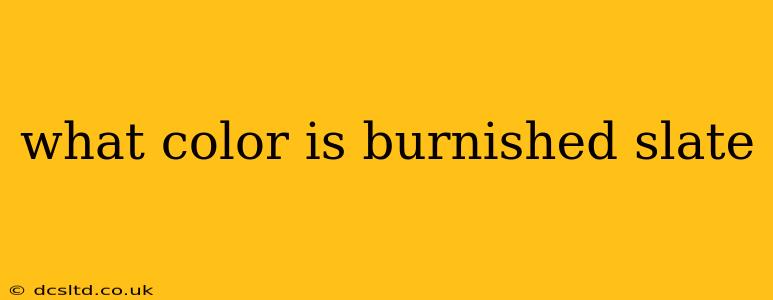Burnished slate is a captivating color often used in interior design and exterior applications. But pinning down exactly what color it is proves tricky, as it's a nuanced shade with subtle variations depending on lighting and the specific manufacturer. This post delves into the complexities of burnished slate, exploring its typical hues and how they're perceived.
What is Burnished Slate?
Before we dive into the color, let's understand the term "burnished." Burnishing is a process of polishing a surface to create a smooth, lustrous finish. In the context of color, "burnished slate" evokes a sense of depth and richness, hinting at a sophisticated, slightly muted tone. It's not a bright or vibrant color but rather a subdued and elegant one.
So, What Color Is Burnished Slate?
Generally speaking, burnished slate is considered a dark gray-blue. However, it's far from a simple gray. Depending on the light, it can appear to have undertones of:
- Purple: In low light, or under specific lighting conditions, a purplish hue might emerge.
- Green: Similarly, a subtle greenish undertone can sometimes be detected.
- Brown: A dark, almost charcoal-like brown might be present, depending on the pigment and finish.
Think of it as a chameleon color – its appearance shifts depending on its surroundings. This inherent ambiguity is part of its charm, allowing it to complement various design schemes.
How Does Burnished Slate Compare to Other Colors?
To better understand the color, let's compare it to similar shades:
- Charcoal: Burnished slate is generally lighter and possesses more blue undertones than charcoal, which is a deeper, more pure gray.
- Gunmetal: While sharing a similar darkness, burnished slate leans more toward gray and blue, whereas gunmetal has a stronger metallic silver/gray quality.
- Slate Gray: This is a closer relative but often lacks the depth and subtle color variations found in burnished slate. Burnished slate is richer and more complex.
What are the Different Shades of Burnished Slate?
Manufacturers often create their own variations of "burnished slate," leading to slight differences in the exact hue. This means you might find burnished slate paints or tiles that lean more toward blue in one instance and more toward gray in another. Always check paint swatches or tile samples in the lighting of your intended space to ensure the shade is perfect for your needs.
What is Burnished Slate Often Used For?
Burnished slate’s sophisticated and versatile nature makes it a popular choice for:
- Interior walls: It creates a dramatic and calming backdrop.
- Exterior siding: It adds a touch of elegance to homes.
- Kitchen cabinets: It offers a modern and stylish look.
- Bathroom tiles: It imparts a sense of serenity and luxury.
Is Burnished Slate a Warm or Cool Color?
This depends largely on the specific shade and the lighting. Generally, the blue undertones lean it toward a cool color, but the presence of brown or purple undertones can introduce a subtle warmth.
What Colors Go Well with Burnished Slate?
Burnished slate's versatility allows it to pair beautifully with a variety of colors. Consider these complementary options:
- Whites and creams: Create a striking contrast and highlight the slate's depth.
- Warm neutrals: Such as beige or taupe, soften the cool tones of the slate.
- Accents of gold or copper: Add warmth and luxury.
- Other muted tones: Like sage green or dusty rose, create a harmonious and sophisticated palette.
In conclusion, burnished slate is a captivating color with subtle variations, making it a unique and stylish choice for various design applications. Its precise shade depends on lighting and the manufacturer's formulation, making it crucial to examine samples in your space before making a final decision.
